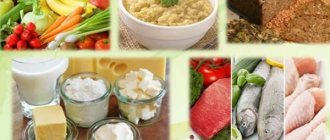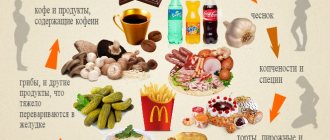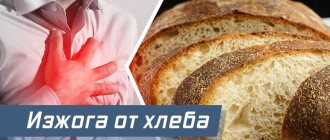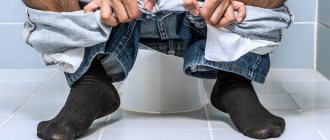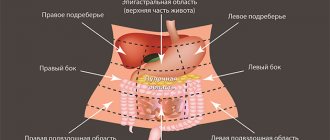Heartburn and related symptoms
The general clinical picture will help determine a preliminary diagnosis and conduct only the necessary studies.
Heartburn 15-20 minutes after eating is the result of dietary errors or stomach diseases. After eating, an “acid pocket” forms in the upper part of the stomach; from this reservoir, the contents flow back into the esophagus. With hyperacid gastritis, heartburn is accompanied by sharp pain in the epigastrium. With hypoacid gastritis, the pain is dull, often combined with constipation and bloating.
Heartburn before or at the beginning of a meal is gastroesophageal reflux.
Heartburn with bile indicates pathology of the liver and gallbladder. A burning sensation in the esophagus occurs 30 minutes to 2 hours after eating, driving or cycling and is accompanied by heaviness/pain in the right hypochondrium.
Heartburn after a course of antibiotics - a violation of the microflora (dysbacteriosis) provokes increased gas formation and an increase in intra-abdominal pressure.
Heartburn and bitterness in the mouth in the morning are the result of overeating at night, following a strict diet for weight loss, and eating “provoking” foods.
Heartburn and diarrhea (diarrhea) are signs of an inflammatory process in the gastrointestinal tract. Body temperature often rises.
Heartburn and bloating - consumption of coarse fiber, overeating, dysbiosis, chronic constipation, intolerance to dairy products.
Cough with heartburn - GERD, smoker's bronchitis.
Heartburn, nausea and vomiting - gastritis, ulcers and erosions of the stomach, side effects of medication. drugs, stomach cancer.
Heartburn, dizziness and weakness - gastrointestinal disease is combined with anemia/hypotension. The sudden appearance of painful symptoms may indicate a hypertensive crisis or developing myocardial infarction. Antacids don't help.
Heartburn and belching - occurs when eating avidly, talking while eating, or a hiatal hernia.
Classification
Taking into account the predominant localization of discomfort, a distinction is made between the more common heartburn in the chest and the less common form with a burning sensation in the throat. To determine the severity of a symptom, the frequency and circumstances of its development, intensity, connection with food intake, and other features of the discomfort experienced are usually used. This approach is effective for conducting a diagnostic search and selecting optimal methods for correcting heartburn, taking into account the causes of its occurrence. Based on the proposed criteria, three degrees of severity of the disorder are distinguished:
- Mild heartburn
. A retrosternal burning sensation appears no more than once a month, is usually provoked by dietary errors, and quickly goes away on its own after correcting the diet. May be accompanied by belching of air or acidic stomach contents. It is observed in 51.4% of men and 48.5% of women without chronic pathology of the digestive organs. - Moderate (moderate) heartburn
. Disturbs the patient 1 to 3 times weekly. It is observed after eating both irritating and familiar foods to the patient. It is often detected as part of a dyspeptic syndrome with nausea, sour or putrid belching. Usually indicates the development of gastroenterological pathology. - Severe (severe) heartburn
. It appears almost every day, combined with belching, nausea, sometimes vomiting, stool instability, and abdominal pain. Often associated with food, although it may occur on an empty stomach. Urgent diagnosis is necessary to determine the disease that caused the symptom. Found in 1.2% of men and 3.4% of women.
Heartburn in pregnant women
Heartburn bothers 30-50% of pregnant women. In the absence of organic damage to the digestive tract, burning along the esophagus (functional heartburn) is caused by hormonally caused relaxation of the lower esophageal sphincter, increased pressure in the abdominal cavity and displacement of the stomach due to an increase in the size of the uterus. However, it is possible that the expectant mother develops a gastrointestinal disease or that an existing pathology has worsened.
Typically, heartburn first appears in the 20th week of pregnancy and torments the woman until childbirth. A common myth is that burning sensation in the esophagus is caused by hair growth on the fetal head. Expectant mothers should take care of proper nutrition and daily routine, and not believe in prejudices.
Pregnant women are not recommended to take antacid medications on their own. First, some medications can negatively affect the fetus. Secondly, it is extremely undesirable to trigger a serious illness. Malabsorption of nutrients can lead to fetal malnutrition and other abnormalities.
Important! Functional heartburn does not harm the unborn baby. The first step to getting rid of a burning sensation in the esophagus is maintaining proper nutrition.
Features of the treatment of GREB with nocturnal hypersecretion of gastric juice
GERD is treated with antisecretory drugs. In the presence of endoscopic signs of GERD, treatment is more effective than when diagnosing non-erosive GERD. In case of ineffective treatment of non-erosive GERD, it is necessary to consider whether the patient is taking medications properly, whether the dose and duration of treatment are sufficient.
If non-erosive GERD is not treated effectively, other conditions should be considered. Often found:
- Functional dyspepsia. With this pathology, antisecretory therapy can relieve symptoms, but not enough.
- Regurgitation in patients with atrial syndrome, which may be associated with impaired peristalsis or lower function of the esophagus.
- Aerophagia.
- Achalasia.
- Eosinophilic esophagitis.
After endoscopic confirmation of GERD, and if there is no therapeutic response, it is necessary to determine whether the patient is taking the drug or dose correctly and check the duration of use, since resistance to PPIs is rare. Resistance is possible mainly due to a genetic mutation in the cytochrome system.
Heartburn in children
In addition to problems with the digestive tract and dietary errors, heartburn in children can be caused by completely non-trivial reasons:
- neurological pathology,
- scoliosis,
- cystic fibrosis,
- ENT pathology,
- lung diseases.
In most children, heartburn is not as severe as in adults. However, unpleasant sensations cause discomfort to babies. Infants arch their backs, often burp, release gases and are capricious. At the same time, even with the slightest nutritional disorder in children, pain comes to the fore. Even slight bloating causes regularly recurring attacks of intestinal colic, and heartburn often leads to vomiting and refusal to eat. This can lead to insufficient weight gain, and uncontrollable vomiting quickly leads to dehydration.
Tips for parents for heartburn in children
- After feeding, the baby should be held upright for a while.
- If you have heartburn, first of all you should analyze your diet and diet, exclude all foods that cause heartburn (including limiting carbohydrates).
- Don't delay visiting the pediatrician. Against the background of prolonged heartburn and indigestion, anemia, apnea, and wheezing in the lungs may develop.
Important! It is necessary to exclude congenital anomalies of the digestive sphincter, intolerance to milk proteins and celiac disease.
Why can't you use soda?
The most famous home remedy for eliminating a burning sensation behind the sternum is baking soda. Alkali neutralizes hydrochloric acid, thereby eliminating the unpleasant symptom. However, it has been proven that the use of this method of treatment only causes harm. In the process of neutralizing the acid, a large amount of carbon dioxide is released, which distends the stomach. This can cause damage to the mucous membrane, and in the presence of an ulcer, even bleeding5. In addition, the environment in the stomach must remain acidic. Therefore, after using soda, the compensatory mechanism for the production of hydrochloric acid starts almost immediately. The result may be even more severe discomfort in the stomach and esophagus5.
Heartburn due to coronavirus
With COVID-19, painful gastrointestinal symptoms, including heartburn, are caused by several factors.
- The coronavirus enters the gastrointestinal tract and provokes functional changes.
- Patients experience significant stress during their illness.
- With COVID-19, chronic diseases often worsen, and in our country up to 85% have problems with the gastrointestinal tract.
- Due to the frequent gastrointestinal symptoms, the “delta” strain of coronavirus has already been called “stomach covid.”
Important! Heartburn with coronavirus, especially in combination with severe weakness, increasing shortness of breath and worsening cough, may indicate a severe course of the disease.
Recent studies have shown that over the next year, patients who have recovered from COVID-19 have a significantly increased risk of developing diabetes mellitus, autoimmune gastrointestinal diseases and psychosomatic disorders, including gastric ulcers. Therefore, if heartburn occurs, patients recovered from coronavirus should visit a gastroenterologist.
Important! Information has appeared in the press that the heartburn drug Famotidine improves the well-being of patients with coronavirus. However, only 10 people participated in the study, and therefore it is premature to talk about the effectiveness of this drug and its safety against COVID-19. We strongly advise against taking Famotidine on your own without a doctor’s prescription.
Causes
Heartburn occurs as a result of the backflow of the contents of the stomach and duodenum into the esophagus. Hydrochloric acid, which is part of the gastric juice, helps digest food, but when it gets on the walls of the esophagus, which are poorly adapted to interact with chemically aggressive liquids, it causes irritation of the mucous membranes and a strong feeling of discomfort2.
The following factors can provoke this:
- weakened tone of the lower esophageal sphincter;
- increased intra-abdominal pressure;
- excess production of gastric juice;
- taking certain medications (sleeping pills, antidepressants, antihistamines);
- alcohol consumption;
- excessive consumption of sweet foods, flour products and spicy seasonings;
- smoking;
- stress;
- prolonged stay in a position with the body tilted forward;
- habit of lying down after eating;
- carbonated drinks;
- frequent consumption of coffee.
An increase in intra-abdominal pressure, in turn, can be contributed to by factors such as obesity, pregnancy, too tight clothing that compresses the abdomen, and heavy lifting.
Heartburn during pregnancy
It occurs as a natural physiological phenomenon: closer to the middle of the second trimester, the growing uterus begins to create excess intra-abdominal pressure, under the influence of which gastric juice refluxes into the lower part of the esophagus.
Heartburn can also be a consequence of gastrointestinal pathologies: stomach and/or duodenal ulcers, gastritis with increased secretion, esophageal sphincter insufficiency, pancreatitis, cholecystitis, reflux gastroesophageal disease, oncological tumors in the stomach, hiatal hernia.
Diagnosis of heartburn
Recommended Laboratory Tests
- General blood analysis.
- Biochemistry and liver tests.
- Test for antibodies to Helicobacter pylori.
- Coprogram.
Instrumental studies
- Urease breath test for Helicobacter.
- FGDS with the possibility of taking a biopsy (to exclude cancer).
- Ultrasound, X-ray with contrast agent and CT.
- Esophageal pH monitoring, esophageal manometry.
If necessary, the patient is referred to an endocrinologist, pulmonologist, cardiologist and other highly specialized specialists.
Treatment of heartburn
- Correction of the diet - do not overeat (especially at night), the last meal is 2.5-3 hours before bedtime, the interval between meals is 4-5 hours, the portions are small.
- Eliminate from the diet all foods that cause heartburn - fatty, fried, spicy, citrus fruits, coffee, alcohol, fresh vegetables and fruits, avoid chewing gum (increases the secretion of gastric juice).
- Allowed dishes: soups, boiled lean meat and fish, porridge (oatmeal, rice, buckwheat), yoghurt, milk (low-fat sour cream, ice cream, cottage cheese in limited quantities), baked apples, boiled vegetables.
- Sleep hygiene is to sleep on your left side with the head of the bed raised. Elevating your upper body by 15% will reduce your risk of heartburn by 50%.
- Symptomatic therapy - before meals, take drugs that neutralize acid (antacids, alginates). It should be remembered that some of them (for example, Almagel) are not recommended for children, and the duration of their use is limited.
- Correction of high gastric acidity and treatment of GERD - proton pump inhibitors.
- Improving the motor function of the gastrointestinal tract - prokinetics (required as prescribed by a doctor; they have serious side effects).
- Antibacterial therapy - when Helicobacter is detected, two or three antibiotics are combined.
- Means for improving digestion - enzymatic preparations.
- General strengthening therapy - vitamins, probiotics.
- Surgical treatment - for severe GERD, gastric ulcers that are refractory to drug therapy.
Drugs for the treatment of heartburn and the underlying disease are selected on an individual basis. Not a single, even the most effective drug will help get rid of heartburn without following a diet.
How to get rid of heartburn after eating?
To eliminate a burning sensation behind the sternum, the following groups of drugs are used:
- Antacids. Mechanism of action: neutralization of hydrochloric acid. Thus, food, even after entering the esophagus from the stomach, does not irritate it. The drugs give a quick but short-term effect5.
- Alginates. They form a special barrier that prevents acid from irritating the esophagus. They are used for symptomatic therapy and do not affect the mechanisms of heartburn formation1.
- Antisecretory drugs. These include proton pump inhibitors5. They suppress the secretion of acid in the stomach, that is, they act directly on the mechanism of heartburn formation5. One of the representatives of this group is Omez 10 mg with the active ingredient omeprazole6. The drug is taken once a day and is valid for 24 hours4.
People sometimes prefer to cope with symptoms with folk remedies. Baking soda for heartburn after eating is the most common method of combating the burning sensation. It is not recommended to use it. Baking soda neutralizes acid in the esophagus and stomach, so it brings short-term relief. However, a compensation mechanism is triggered in the body, causing acid production to increase. The next heartburn attack will be even worse3. The same applies to milk as an emergency remedy for burning sensations. Among folk remedies, the only safe way to alleviate the condition is to drink a glass of clean still water.
Heartburn does not always indicate the presence of a disease. The symptom can occur even in healthy people. But don't ignore the burning sensation that impairs your daily life. Follow the recommendations and you can forget about this condition for a long time.
Bibliography:
- Tytgat GN, McColl K., Tack J. et al. New algorithm for the treatment of gastroesophageal reflux disease // Aliment. Ther. – 2008. – Vol. 27. – P. 249–256.
- Belmer S.V. Gastroesophageal reflux disease // Russian Medical Journal. – 2008. – No. 3. – P. 144-148.
- Ivashkin V.T. Gastroenterology: Clinical guidelines / Ed. V.T. Ivashkina. 2nd ed., rev. and additional – M.: GEOTAR-Media, 2009. – 208 p.
- INSTRUCTIONS for the use of the medicinal product for medical use OMEZ10 mg LP 00328 dated 07/11/17 Date of access 11/26/18
- Minushkin O.N., Maslovsky L.V., Loshchinina Yu.N., Anikina N.Yu. Omeprazole in the treatment of patients with gastroesophageal reflux disease // Effective pharmacotherapy in gastroenterology. – 2009. – No. 1, pp. 20-26.
- Ivashkin V.T., Maev I.V., Trukhmanov A.S. and others. Gastroesophageal reflux disease. Clinical recommendations // Russian Gastroenterological Association. M., 2014. 23 p. .
Preventing heartburn
- Eliminate heavy lifting.
- Sleep at least 7 hours.
- Do not bend over or go to bed for 1.5-2 hours after eating.
- Avoid corsets, bandages and tight trousers.
- Quit smoking, don't abuse alcohol.
- Get rid of extra pounds.
- Don't skip preventive examinations.
- When the first complaints appear, consult a doctor.
- If you have gastrointestinal diseases, visit a gastroenterologist 2 times a year.
- Control of emotional state, help from a psychologist.
Taking into account the increasing number of cancers, which at the initial stage manifest themselves with minimal symptoms, recurrent or constant heartburn cannot be ignored. Contact the First Family Clinic of St. Petersburg. You will undergo the necessary studies, and gastroenterologists will prescribe effective treatment.
Risk factors
In most cases, a burning sensation behind the sternum is caused by a violation of the diet and diet. Certain lifestyle habits also increase the risk of developing symptoms. The main risk factors for developing heartburn after eating:
- Binge eating. Both one-time during the holidays, and permanently due to incorrect eating habits: large portions, eating 1-2 times a day.
- Rest lying down immediately after eating.
- Abuse of certain foods (sweets, fried and fatty foods, chocolate, coffee, strong tea, sour foods, spicy foods and others).
- Excess weight due to increased intra-abdominal pressure. By the same principle, pregnant girls are susceptible to heartburn, especially in the last trimester.
- Wearing tight, tight clothing that does not fit. Especially with excessive pressure on the waist.
- Smoking helps relax the sphincter between the esophagus and stomach.
- Taking certain medications: antihypertensives, sedatives, antidepressants, antiarrhythmics (you cannot stop taking prescribed medications on your own, you must first consult the doctor who prescribed them)2,3,4.
The listed risk factors can cause an unpleasant symptom even in a completely healthy person. Also, pain and heartburn after eating can be a sign of certain diseases. Gastroesophageal reflux is one of the main manifestations of gastroesophageal reflux disease. It is characterized by persistent relaxation of the muscular sphincter between the esophagus and stomach. The disease can be suspected if heartburn bothers you once a week or more often for at least 3 months4.

